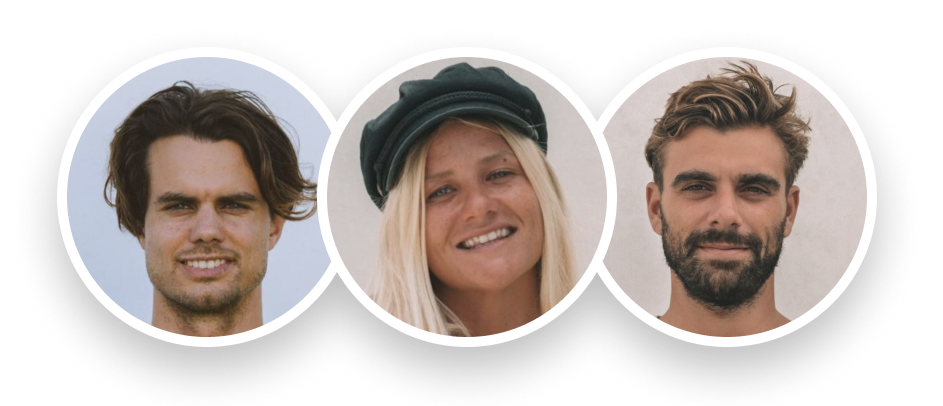As a surf coaching retreat organization, we carefully choose where and when to run our trips based on seasonal averages and historical surf forecasts. No one can guarantee perfect surf (wave pools excluded!), but by aligning our calendar with the best seasons, we maximize the chances of getting fun, consistent waves.
This guide explains why we go to each destination, what guests can expect, and the main advantages and trade-offs for each location.
Central America – Costa Rica & Nicaragua
(Beginners & Intermediates)
The Pacific Coast of Central America has been the heart of our retreats since 2012. This region delivers some of the most consistent waves in the world. After more than a decade, we’ve yet to see a truly “flat” day! Add tropical water, high-quality beach breaks, and easy access from North America (and not too far from Europe), and it’s clear why we keep coming back.
Nosara, Costa Rica – January to March

We start the year in the tropical surfing paradise of Nosara, Costa Rica. November to March is the “small wave season”, when surfers can expect the average day to be waist to shoulder high in Playa Guiones. This is the ideal location for small waves, as this 7-km long beach is a true “wave magnet,” getting swells from the South, West and North.
Even on the smallest days, with 2-foot swells, surfers can enjoy clean, waist-high peeling waves on this beach break; perfect to improve their technique. In addition, January to March is the middle of the dry season, meaning guests are practically guaranteed sunshine every day (averaging less than one rainy day per month).
Pros of Costa Rica during this time
- Consistent 2 – 4 foot quality waves
- Waves are easy to read & peel gently
- Safe environment with sand bottom
- Consistently clean conditions until 10 – 11 am practically every day
- Sunshine & blue skies are almost certain in the dry season
Cons of Costa Rica during this time
- It’s the “high season”; prices are higher
- Onshore winds from 10-11 am (although they often calm down at sunset, which is perfect for a quick session!)
- It’s busier in the water during this time*
- Waves can sometimes be too gentle for advanced intermediates**
Note: Even though Guoines can get busy, it is quite a wide beach break & can handle lots of surfers. We try to surf early (6 am) or a bit later, around 8 – 9 am, to escape the bigger crowds. We also don’t operate during the Thanksgiving & Christmas holidays, as it gets too busy.
If you’re looking for more powerful waves to do snaps, re-entries, fins-out & other more “vertical manoeuvres,” Guiones might not be the best destination. The waves are still very rippable, but they usually peel gently. This is great for practicing turns, cutbacks & more “horizontal maneuvers,” but it makes it harder to perform more advanced intermediate maneuvers that are more “vertical” towards the lip.
San Juan del Sur, Nicaragua – April to July
(Beginners & Intermediates)

From Costa Rica, we move to our second destination, only a few hours North: San Juan del Sur, Nicaragua. The South Pacific coast of Nicaragua is a unique place in the world. Due to Lake Nicaragua, the winds blow offshore for over 300 days per year. This provides clean, predictable and fun waves. In addition, since surfers have favourable winds for the whole day, the crowds are usually thinner (surfers have a 12-hour window instead of a 3-4 hour one!).
April to August is part of the “swell season.” On average, the waves are bigger during this time, usually between chest high and head high+. However, San Juan del Sur’s coastline offers many options to surf, no matter if the swell is big or small. For example, waves might be 2 feet overhead at an open beach break North of San Juan, but they might only be shoulder high at a “bay-shaped” beach 15 minutes South on the same day. The variety of options for both big and small waves and consistent offshore winds makes this the perfect location for the swell season.
Pros of Nicaragua during this time
- Very consistent & safe waves with sand bottom
- A multitude of spots to handle big or small conditions
- Offshore all day 300+ days/year
- Thinner crowds
- Cheaper destination
Cons of Nicaragua during this time
- Higher chances of rain*
- Possibility of a few stormy days, providing poorer conditions
- More driving around to get waves, depending on daily conditions
*Guests sometimes worry about the rain, as May to November is considered the wet season. The rainiest months are September and October. During those months, it can rain all day for several days in a row. April to August is the “start of the wet season.” From our experience in the past 10+ years, the average day is sunny with clouds, and there are sometimes heavy rains, either during late afternoon or evening, that don’t go on for too long (which we find refreshing in this climate).
There are a few rainy days per month. However, San Juan del Sur has a drier climate and receives less rain than Nosara during the wet season (probably because of its micro-climate with Lake Nicaragua, but we aren’t Meteorologists!). You could be unlucky and have 2 – 3 rainy days during your trip, but usually, it’s a mix of sunshine with short & heavy rainfalls from April to August. It all comes down to your tolerance of risk. If you want to be sure to have blue skies every day, Costa Rica from January to March would be a safer bet. We think the high chances of getting good weather and amazing waves with small crowds make this a very good choice!
The Mentawais, Indonesia — October to November
(Intermediate retreats only)

We usually run our intermediate surf coaching retreats in autumn, from October to November. For the Mentawais, this is considered the “shoulder season,” when the waves are generally not as big and intimidating for our intermediate students as during the peak swell season.
In addition to more user-friendly conditions, these perfect reef breaks are generally less crowded during this period of the year, which is a big factor. From our experience, thinner crowds make a massive difference for our intermediate students.
Pros of the Mentawais during this time
- More user-friendly conditions
- Fewer chances of big swells
- Still has consistent waves
- Thinner crowds
Cons Mentawais during this time
- May require more cruising around to find waves
- If it gets very small, some spots can get busy (as the few “swell magnets” become the only options)
Still have questions?
Don’t hesitate to reach out to our team at info@barefoosurftravel.com

